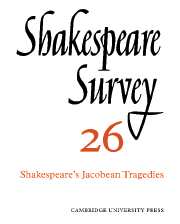Book contents
- Frontmatter
- Studies in Shakespearian and Other Jacobean Tragedy, 1918–1972: A Retrospect
- ‘Form and Cause Conjoin’d’: ‘Hamlet’ and Shakespeare’s Workshop
- The Art of Cruelty: Hamlet and Vindice
- From Tragedy to Tragi-Comedy: ‘King Lear’ as Prologue
- Jacobean Tragedy and the Mannerist Style
- ‘King Lear’ and Doomsday
- Macbeth on Horseback
- Shakespeare’s Misanthrope
- ‘Antony and Cleopatra’ and ‘Coriolanus’, Shakespeare’s Heroic Tragedies: A Jacobean Adjustment
- Shakespeare’s Venus and Adonis Sonnets
- Orlando: Athlete of Virtue
- The Unfolding of ‘Measure for Measure’
- Shakespeare and the Eye
- No Rome of Safety: The Royal Shakespeare Season 1972 Reviewed
- The Year's Contributions to Shakespearian Study 1 Critical Studies
- 2 Shakespeare’s Life, Times, and Stage
- 3 Textual Studies
- Index
- Plate section
From Tragedy to Tragi-Comedy: ‘King Lear’ as Prologue
Published online by Cambridge University Press: 28 March 2007
- Frontmatter
- Studies in Shakespearian and Other Jacobean Tragedy, 1918–1972: A Retrospect
- ‘Form and Cause Conjoin’d’: ‘Hamlet’ and Shakespeare’s Workshop
- The Art of Cruelty: Hamlet and Vindice
- From Tragedy to Tragi-Comedy: ‘King Lear’ as Prologue
- Jacobean Tragedy and the Mannerist Style
- ‘King Lear’ and Doomsday
- Macbeth on Horseback
- Shakespeare’s Misanthrope
- ‘Antony and Cleopatra’ and ‘Coriolanus’, Shakespeare’s Heroic Tragedies: A Jacobean Adjustment
- Shakespeare’s Venus and Adonis Sonnets
- Orlando: Athlete of Virtue
- The Unfolding of ‘Measure for Measure’
- Shakespeare and the Eye
- No Rome of Safety: The Royal Shakespeare Season 1972 Reviewed
- The Year's Contributions to Shakespearian Study 1 Critical Studies
- 2 Shakespeare’s Life, Times, and Stage
- 3 Textual Studies
- Index
- Plate section
Summary
Credit for the definition, if not the invention, of tragi-comedy in England is normally given to John Fletcher and is firmly anchored in his preface to the printed edition of The Faithful Shepherdess of 1609/10:
A tragi-comedy is not so called in respect of mirth and killing, but in respect it wants deaths, which is enough to make it no tragedy, yet brings some near it, which is enough to make it no comedy, which must be a representation of familiar people, with such kind of trouble as no life be questioned; so that a god is as lawful in this as in a tragedy, and mean people as in a comedy.
The Faithful Shepherdess was first performed in 1608 or 1609, and it is probable that the collaborative hand in Shakespeare's Henry VIII of 1612/13 was Fletcher's. Since this five-year time-span neatly embraces the period during which Shakespeare directed his primary artistic endeavour to tragi-comedy, with Pericles, Cymbeline, The Winter's Tale and The Tempest following one another in swift succession, it has been generally assumed that this sharp shift of direction was the product of Fletcher's influence, coupled with influences flowing in from Italy and France in the wake of the Counter-Reformation and those of the Masques which Ben Jonson and Inigo Jones were developing with such success at court in these years.
- Type
- Chapter
- Information
- Shakespeare Survey , pp. 33 - 48Publisher: Cambridge University PressPrint publication year: 1973
- 4
- Cited by

